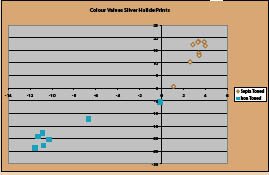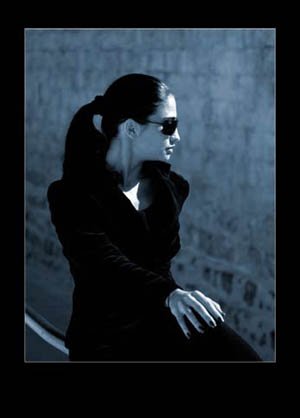articles/Paper/epsontraditional-page2
Paper Chase - Epson Traditional Photo Paper - part 2 of 1 2 3 4
by Mike McNamee Published

Monochrome Performance
The Dmax was a typical baryta value of 2.18. We squeezed a little more off an unprofiled print at 2.33. The metamerism was low at 1.0 for the 50% Lightness swatch (D65 to Tungsten). The neutrals were mapped to the cool base (the paper is almost 5 Lab points blue. The greyscale was almost perfectly linear right down to the deepest black at 5.8% Lightness. Visually the shadows blocked at 20 RGB points, typical of a profiled printer.
This is a paper, like its companions, that has an uncanny likeness to a traditional air-dried fibre-base silver halide paper. With its weight and rich blacks it creates a striking impression

Blue iron toning using Pantone 5405 in Overlay Mode at 100% opacity.
Making Prints
The audit print was indistinguishable from that made with other baryta-based media except for a slight variations in the 'shapes' within the Granger Chart. We remain huge fans of this class of paper. Epson had kindly provided sufficient material for us to get to grips with some real test printing and we started with monochrome. Taking a cue from the Ilford press release we investigated various traditional toned effects but started by measuring some real silver halide prints. For simplicity we chose to use Pantone colours to introduce the colour element of tone although we recognise that there are dozens of ways of completing the task.
The graph shows the scatter plots from multiple readings off a thiocarbamide, sepia-toned print in which the sodium hydroxide level had been adjusted to give a more purple hue rather than the more yellow-green that we dislike. The blue-toned print was iron toned with a ferrous ammonium citrate-potassium ferricyanide-sulphuric acid concoction - oh happy days! In reality this slightly unstable technique produces a rather weak cyan tone which may or may not last the course, some of our examples have lasted 10 years others have definitely not - fading is not just an inkjet problem! In both cases we measured both the old silver print and the final inkjet, they were remarkably similar.
Please Note:
There is more than one page for this Article.
You are currently on page 2
- Paper Chase - Epson Traditional Photo Paper page 1
- Paper Chase - Epson Traditional Photo Paper page 2
- Paper Chase - Epson Traditional Photo Paper page 3
- Paper Chase - Epson Traditional Photo Paper page 4
1st Published
last update 09/12/2022 14:54:01
More Paper Articles
There are 0 days to get ready for The Society of Photographers Convention and Trade Show at The Novotel London West, Hammersmith ...
which starts on Wednesday 14th January 2026




